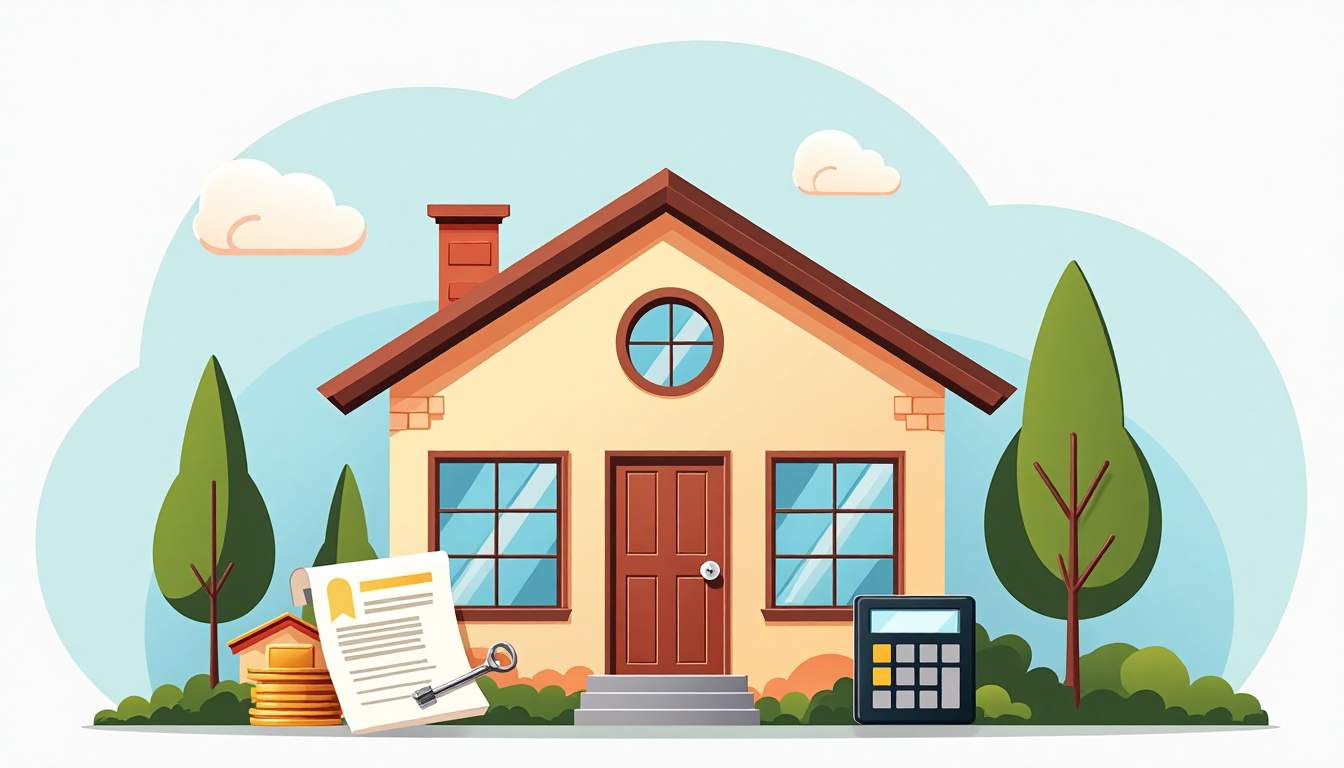Discover the essentials of home loan basics and learn how to finance your dream home with confidence.
Home Loan Basics: A Comprehensive Guide to Financing Your Dream Home
Buying a home is one of the most significant financial decisions many people will ever make. For most, securing a home loan is a necessary step to turning the dream of homeownership into reality. However, navigating the world of mortgages can be complex and overwhelming without the right information. This comprehensive guide breaks down the essentials of home loans, helping you understand the process, the types of loans available, and how to prepare for financing your dream home.
Understanding What a Home Loan Is
A home loan, also known as a mortgage, is a type of loan specifically designed to help individuals purchase a property. Because most people don’t have the full purchase price saved up, a lender provides the funds to buy the home, and the borrower agrees to repay the loan over time, usually with interest.

When you take out a mortgage, the home itself serves as collateral. This means if you fail to make payments, the lender has the right to take ownership of the property through foreclosure. Understanding this relationship is crucial because it underscores the importance of making timely payments and choosing a loan that fits your financial situation.
How Home Loans Work
Typically, a home loan involves borrowing a principal amount, which is the money you need to buy the house, and paying it back with interest over a set period, known as the loan term. Common loan terms are 15, 20, or 30 years. Your monthly payment usually includes the principal repayment, interest, property taxes, and homeowner’s insurance.
The interest rate is a critical component of your mortgage. It determines how much extra you pay on top of the principal. Interest rates can be fixed, meaning they stay the same throughout the loan term, or variable, meaning they can fluctuate based on market conditions.
Types of Home Loans
Choosing the right type of home loan is essential because it affects your monthly payments, total interest paid, and flexibility. Here are some of the most common types of home loans available:
Fixed-Rate Mortgages
Fixed-rate mortgages offer a consistent interest rate and monthly payment over the life of the loan. This predictability makes budgeting easier and protects you from rising interest rates. Fixed-rate loans are popular for those who plan to stay in their home for a long time.
The most common fixed-rate loan terms are 15 and 30 years. While 30-year loans have lower monthly payments, they typically cost more in interest over time compared to 15-year loans.
Adjustable-Rate Mortgages (ARMs)
Adjustable-rate mortgages start with a lower fixed interest rate for a set period, often 5, 7, or 10 years, then adjust annually based on market rates. This can be advantageous if you plan to sell or refinance before the adjustable period begins, but it carries the risk of higher payments if interest rates rise.
ARMs are suitable for buyers who expect their income to increase or who anticipate moving within a few years. However, understanding the terms and caps on interest rate changes is vital to avoid surprises.
Government-Backed Loans
For many first-time homebuyers or those with less-than-perfect credit, government-backed loans can be a helpful option. These loans are insured or guaranteed by government agencies, which reduces risk for lenders and often allows for lower down payments and more flexible qualifying criteria.
Popular types include:
- FHA Loans: Insured by the Federal Housing Administration, these loans require as little as 3.5% down and are accessible to buyers with lower credit scores.
- VA Loans: Available to veterans and active-duty military members, VA loans often require no down payment and have competitive interest rates.
- USDA Loans: Designed for rural and suburban homebuyers, these loans offer zero down payment options and favorable terms.
Preparing to Apply for a Home Loan
Before applying for a home loan, preparation is key. Lenders will scrutinize your financial situation to determine your eligibility and the terms they can offer. Here are the essential steps to get ready:
Check and Improve Your Credit Score
Your credit score is one of the most important factors lenders consider. It reflects your history of managing debt and paying bills on time. Higher credit scores typically result in better interest rates and loan terms.
To improve your credit score, pay down existing debts, avoid opening new credit accounts before applying, and correct any errors on your credit report. Regularly monitoring your credit can help you identify areas for improvement.
Calculate Your Budget
Understanding how much you can afford is crucial. Consider your monthly income, existing debts, and other expenses. Many financial experts recommend that your total housing costs (including mortgage, taxes, and insurance) should not exceed 28-30% of your gross monthly income.
Using mortgage calculators can help you estimate monthly payments based on different loan amounts, interest rates, and terms. This insight can guide you in setting a realistic price range for your home search.
Save for a Down Payment and Closing Costs
The down payment is the upfront amount you pay toward the purchase price of your home. While some loans allow for low or no down payment, putting down at least 20% can help you avoid private mortgage insurance (PMI), which adds to your monthly costs.
Additionally, closing costs—which include fees for appraisals, inspections, title insurance, and lender charges—typically range from 2% to 5% of the loan amount. Planning for these expenses ensures you won’t be caught off guard at closing.
The Home Loan Application Process
Once you’re prepared, the next step is to apply for a home loan. Understanding the process can help reduce stress and speed up approval.
Pre-Approval vs. Pre-Qualification
Pre-qualification is an initial assessment where a lender estimates how much you might be able to borrow based on self-reported information. It’s a helpful starting point but not a guarantee of loan approval.
Pre-approval is a more rigorous process involving a credit check and verification of your financial documents. A pre-approval letter shows sellers that you are a serious buyer and can strengthen your negotiating position.
Submitting Your Loan Application
When you find a home and have an accepted offer, you’ll submit a formal loan application. This requires providing detailed financial documents such as pay stubs, tax returns, bank statements, and information about your debts and assets.
The lender will review your application, order an appraisal to confirm the home’s value, and verify your financial information. This underwriting process can take several weeks, depending on the lender and complexity of your file.
Loan Approval and Closing
If your application meets the lender’s criteria, you’ll receive a loan commitment letter outlining the terms. Before closing, you’ll review the closing disclosure, which details the final loan costs and monthly payments.
At closing, you’ll sign all necessary documents, pay closing costs, and officially take ownership of your new home. It’s important to review everything carefully and ask questions if anything is unclear.
Tips for Managing Your Home Loan Successfully
Securing a home loan is just the beginning. Managing your mortgage responsibly can save you money and protect your investment.

Make Payments on Time
Consistently making your mortgage payments on time is vital. Late payments can damage your credit score and lead to penalties or even foreclosure. Setting up automatic payments or reminders can help you stay on track.
Consider Refinancing When Appropriate
Refinancing your mortgage can be beneficial if interest rates drop significantly or your financial situation improves. It can lower your monthly payments, reduce your loan term, or allow you to tap into home equity. However, refinancing involves fees and closing costs, so it’s important to weigh the benefits against the costs.
Build Equity and Protect Your Investment
As you pay down your mortgage, you build equity—the portion of your home you truly own. Making extra payments toward the principal can accelerate this process and reduce interest paid over time.
Maintaining your home and keeping up with property taxes and insurance protects your investment and ensures you won’t face unexpected financial burdens.
Common Home Loan Mistakes to Avoid
Even with careful planning, some pitfalls can derail your home loan experience. Being aware of common mistakes can help you avoid them.

Overextending Your Budget
It’s tempting to stretch your budget to buy a dream home, but taking on a mortgage that’s too large can lead to financial strain. Stick to a comfortable price range and factor in all homeownership costs.
Ignoring Loan Terms and Fine Print
Every mortgage has specific terms, conditions, and fees. Failing to read and understand these details can result in surprises, such as prepayment penalties or adjustable rate increases. Always ask your lender to explain anything unclear.
Making Big Financial Changes During the Process
After applying for a loan, avoid making major financial moves like changing jobs, opening new credit accounts, or making large purchases. These actions can affect your creditworthiness and jeopardize loan approval.
Final Thoughts
Financing a home can seem daunting, but with the right knowledge and preparation, it becomes a manageable and rewarding journey. Understanding the basics of home loans, knowing your options, and preparing your finances will empower you to make informed decisions and secure the best possible mortgage for your dream home.
Remember, buying a home is not just about the loan—it’s about building a foundation for your future. Taking the time to educate yourself and work with trusted professionals can make all the difference in achieving your homeownership goals.
Explore More with Digital Loan Bazar
Ready to take the next step in financing your dream home? Visit Digital Loan Bazar for more expert insights and practical tips tailored to help you master your finances in India. From applying for the right home loan to managing your money wisely, our resources are designed to guide you through maximizing life's opportunities. Don't miss out—click through to Read More and take control of your financial future today.




0 Comments